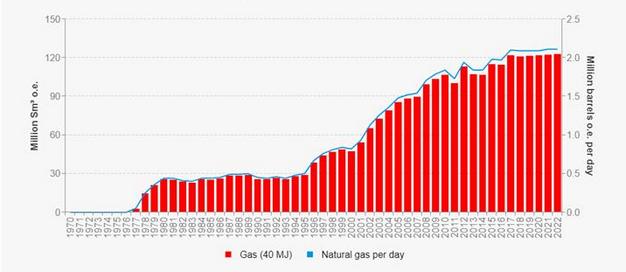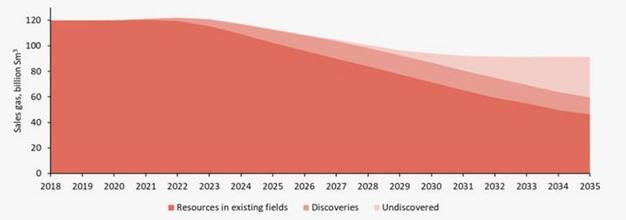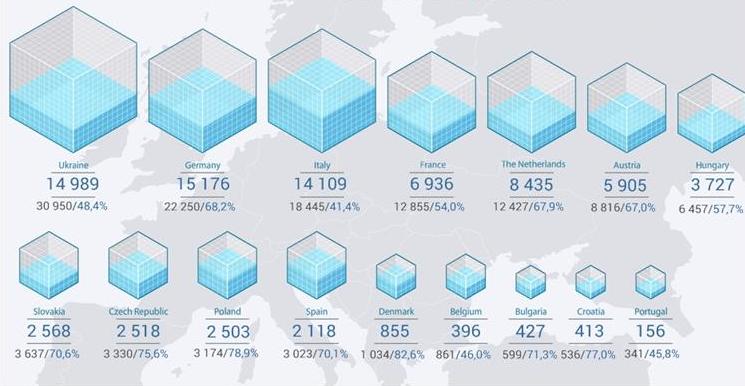The role of LNG in European energy security
The increased role of liquefied natural gas (LNG) in the future European energy mix will be a significant European card against Russia in the future Eurasian geopolitics and energy chessboard.
Athanasios Pitatzis is an Industrial/Petroleum Engineer and Alternate Committee Member of the Greek Energy Forum. He specializes in the development of oil & gas and power markets in the UK and the Southeast Europe and the Mediterranean. The opinions expressed in the article are personal and do not reflect the views of the entire forum or the company that employs the author.
Europe, according to CEDIGAZ (the International Association for Natural Gas, previous chart), consumed around 510 to 520 billion cubic meters of natural gas in 2016. According to the European Commission, for the year 2016, the European Union's 28-member gas imports were covered by: Russia accounting for 39.5% of total imports, Norway accounting for 34.4% of total imports, Algeria accounting for 15.1% of total imports, Qatar accounting for 5.0% of total imports and, from other sources, accounting 6.0% of total imports [2].

Annual Natural Gas Exports until 2016 and with a forecast to 2022, Source: Norwegian Petroleum Directorate, Retrieved on 16/01/2018, http://www.norskpetroleum.no/en/production-and-exports/exports-of-oil-an...
----------------------------------------------------------------------
According to the Norwegian Petroleum Directorate, Norway exported 115 billion cubic meters of natural gas to Europe in 2016. It is obvious that Norway plays an important component/role of European Energy Security [3].
Future exports of natural gas from Norway to Europe will be affected by the following factors:
- The Future European and Norway Energy Policy
- International Future Gas and Petroleum Prices
- Future gas prices of the European "hub"
- Future discoveries of new natural gas fields in Norway's Exclusive Economic Zone (EEZ)
- The level of future EU internal gas production
- The geopolitical relations of the EU with Russia.

Future Natural Gas Sales by the Norwegian Gas Fields from 2018 to 2035, Source: Norwegian Petroleum Directorate, Retrieved on 16/01/2018, http://www.norskpetroleum.no/en/production-and-exports/exports-of-oil-an...
------------------------------------------------------------------------------------
From 2022 onwards, the reduction in Norway's natural gas production with the simultaneous reduction of European gas production poses the crucial energy dilemma in the EU, replacing all these quantities with cheap Russian gas or paying a more high price for LNG imports. The choice of LNG is the right direction for the European Energy Security. Another important element of European Energy Security is the natural or artificial natural gas storage sites.
According to Naftogaz, (the largest natural gas and oil company in Ukraine), European countries have the following natural gas storage capacities:
-Ukraine: 31 billion cubic meters of natural gas storage capacity (billion: billions)
-Germany: 22.250 billion cubic meters of natural gas storage capacity
-Italy: 18.44 billion cubic meters of natural gas storage capacity
-France: 12.88 billion cubic meters of natural gas storage capacity
-The Netherlands: 12.42 billion cubic meters of natural gas storage capacity
-Hungary: 6.3 billion cubic meters of natural gas storage capacity
-Austria: 8.8 billion cubic meters of natural gas storage capacity
-England: 4.6 billion cubic meters of natural gas storage capacity (2015 figures)
-Slovakia: 3.6 billion cubic meters of natural gas storage capacity
-Czech Republic: 3.3 billion cubic meters of natural gas storage capacity
-Poland: 3.1 billion cubic meters of natural gas storage capacity
-Spain: 3.0 billion cubic meters of natural gas storage capacity
-Denmark: 0.9 billion cubic meters of natural gas storage capacity
-Belgium: 1.0 billion cubic meters of natural gas storage capacity
-Bulgaria: 0.55 billion cubic meters of natural gas storage capacity
-Croatia: 0.53 billion cubic meters of natural gas storage capacity
-Portugal: 0.34 billion cubic meters of natural gas storage capacity
The total Gas Storage Capacity in Europe is 133.01 billion cubic meters. [4].

European Levels of Natural Gas Storage on 24/12/2017, Source: Naftogaz Europe, Gas Balances in European Underground Storages, 26/12/2017, http://naftogaz-europe.com/article/en/GasBalances
------------------------------------------------------------------------------------------
Europe can save approximately 26% of its annual gas consumption, a factor that gives several advantages in shaping the future of European Energy Security. In addition, Europe has many high-capacity liquefied natural gas import terminals, which it plans to increase over the next few years. Of course, the utilization of these infrastructures is very low.
